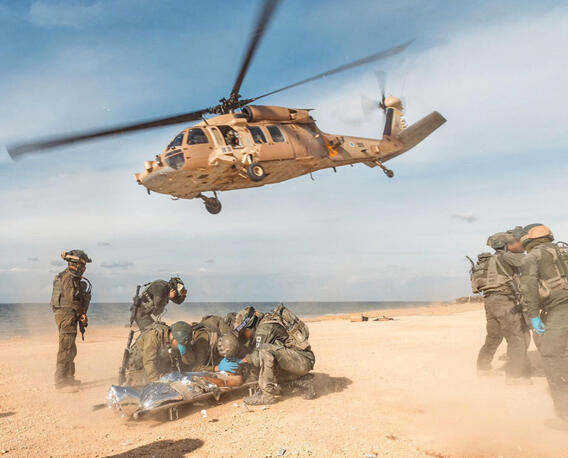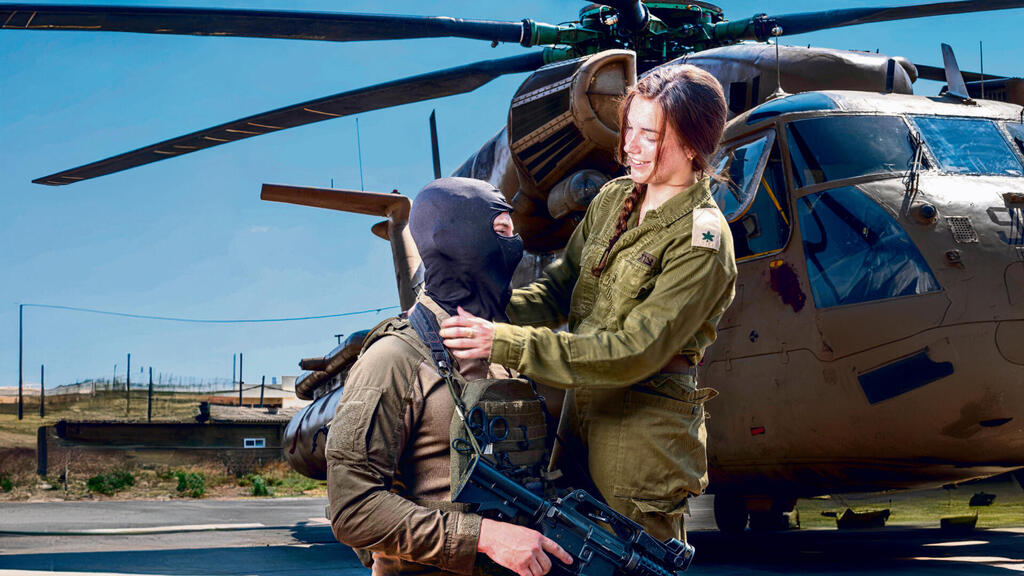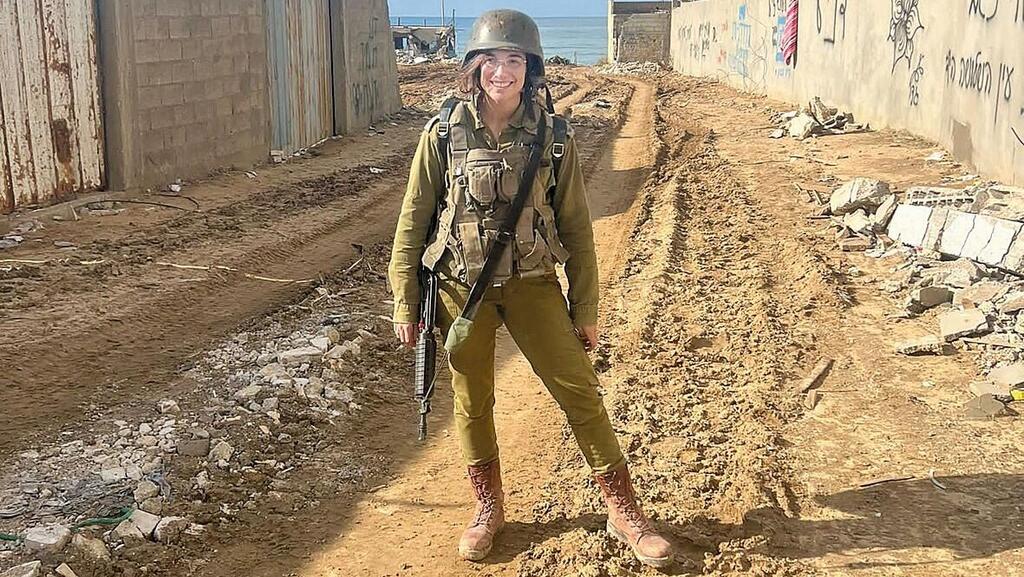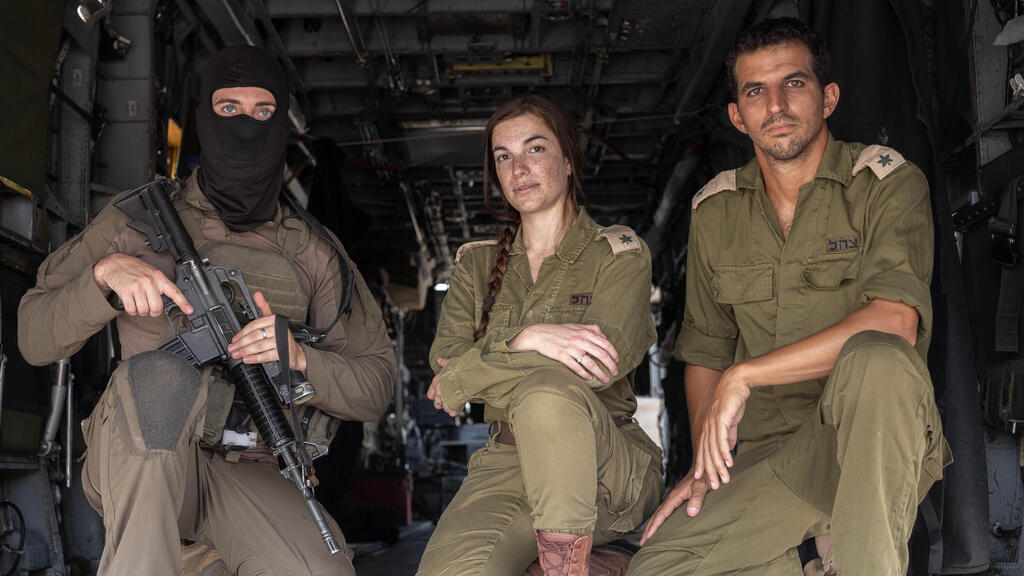Getting your Trinity Audio player ready...
October 8, 12:25 PM, a text message between Noga, the Head of Operational Command for the Paratrooper's Special Forces brigade, and Guy, a reserve combat paramedic in Unit 669:
Noga: "I need a rescue helicopter. We've got casualties. Can you help me?"
Guy: "What's the situation? Give me details."
Noga: "We have three wounded."
Guy: "Location?"
This brief, technical exchange is emblematic of the chaos of October 7 and the days that followed. Even the sharpest observer wouldn't guess that this conversation was between an engaged couple who had already set a date and venue for their wedding.
This happened just over a day after the horrific attack began. Terrorists were still roaming in Israel, and the fighting continued. "Our unit's deputy commander was seriously wounded," Noga recalls. "They thought he was dead; someone even said so. I couldn't get through to the command center to request a rescue helicopter—no one was responding. It was a state of helplessness. So, I sent a WhatsApp to Guy, who was also in combat. It wasn't a conversation between partners."
Guy: "I contacted a friend from 669 who serves at the Air Force's control center."
Noga: "That's how I got a helicopter. It's one of the reasons why the unit's deputy commander is alive today. After a challenging six-month rehabilitation, he returned to his position and is back on the ground again in Gaza."
The next interactions between Noga and Guy were more intimate, but the circumstances were no less surreal. "I was managing the combat headquarters of the unit, and we had set up a temporary command station in Sderot, which was still being heavily bombarded. I asked Guy to update me on his location," says Noga, 27, who is about to complete her legal internship at the Supreme Court. "On October 9, Guy sent me a message: 'We're in Kissufim.' Shortly after, I received a report of a shooting in Kissufim. Terrorists were opening fire and ambushing soldiers. I knew he was there. I tried calling Guy, but he didn't answer. I kept calling, but there was no response. I felt like I couldn’t breathe. For forty minutes, I was certain the worst had happened. Yet, I had to keep operating, overseeing my unit’s combat efforts and giving the impression that everything was under control, even though it was far from reality."
Guy, 30, a medical student at Tel Aviv University, tells what was happening from his perspective: "As we were searching for Hamas gunmen who managed to ambush Golani Battalion soldiers and then managed to escape, we were ambushed. I was behind, not on the front line. We had seven guys wounded, two of them critically. We loaded them onto our Hummers and drove as fast as we could to a nearby open field and called in for a 669 rescue helicopter.
While treating two casualties simultaneously—one with a gunshot wound to the head and the other with a round in the chest—I felt my phone vibrating in my pocket. In the midst of chaos, no call is more important than the wounded person bleeding and not breathing in front of you. We had arrived at the field location we coordinated with central command and were waiting for a helicopter, but the phone kept vibrating. I thought someone from 669 on the helicopter might be calling to locate us. I checked my phone and saw numerous missed calls from Noga. I called her back immediately, fearing something might have happened to her. She choked up on the phone, saying, "I thought something happened to you.
"Noga: "That was the first time I cracked. I cried with relief."
Noga and Guy married amid the war and during the emergency call-up, which has continued until today. They met maybe three or four times from October 7 until the big day. One of the meetings was when Noga asked Guy to bring her a package she ordered online for the wedding. "It was a white dress for the dancing part, and I needed to see if it fit. I asked Guy to bring the package to the Gaza border."
Guy: "I drove south and met Noga at an abandoned house near the border, where her team had been sleeping on the floor for months. The truth is I didn't know what was in the package. Noga opens the box, puts on the dress, and stands in front of the mirror. I see a smile spread across her face. And it's no longer the tired officer who just finished an exhausting shift. At that moment, she was Cinderella."
Noga: "Guy hugged me. It was a magical moment."
Apart from the wedding and its preparations, Guy and Noga didn't experience many magical moments during the war. Guy recounts the events of October 7 and the war from his perspective as a combat paramedic in 669 and from the viewpoint of his teammates in his new book The Rescue- October 7 through the eyes of Israel’s Para Rescue Commandos, His first book, From Zero to One Hundred, published a few years ago, is a gripping diary of his special forces rescue team’s experiences during mandatory service. It has become essential reading for teenagers aspiring to join elite units and is popular with the general public.
October 7 is a date etched into the memory of every Israeli. For Guy and his family, however, another date—September 30—was equally significant, just a week before the Hamas attack. "I was on a trip to Georgia during the holiday of Sukkot with my parents and all my siblings," says Guy. "On Saturday evening, we were dining in a local restaurant in a remote village in the Caucasus Mountains. My dad seemed pale, sweating, and unwell. I thought it might be food poisoning from some khachapuri. Suddenly, his head slumped onto the plate, and his glasses broke."
"My brother Ari, a commander and medic in the army, immediately sprang into action. He laid our father on the floor and elevated his legs. I knelt beside him, instinctively placing my hand on his neck and finding no pulse. It took about ten seconds for the gravity of the situation to hit me. I began performing CPR, questioning whether my compressions were deep enough and if the rhythm was correct. At the same time, I found myself saying goodbye to Dad, imagining how he wouldn't be there at my wedding and how much he loved Noga. Those two minutes felt like an eternity. Then, finally, he started showing signs of breathing.
Meanwhile, a local ambulance arrived at the restaurant. "More accurately, an old pickup truck with two Georgian grandmothers and no equipment at all. We're driving to the hospital - and there's not much equipment there either. One defibrillator in the whole complex. I struggle with the team to get him into catheterization, and then he goes into cardiac arrest again. It took two and a half days to bring him back to Israel on a medical flight accompanied by a friend who is an intensive care doctor. At Shaare Zedek Hospital in Jerusalem, doctors discovered an electrical issue with his heart. They implanted a pacemaker, and now he’s doing fine. Thank God.
In 669 you've done quite a few resuscitations, both before October 7 and during the war. What's the difference between treating your father and treating a soldier or civilian you don't know?
"I believe the deepest fear for any medical professional is having to use their skills on someone they love. The fear was even greater in our case because we were alone. Suddenly, my father's life was in my hands".
"Was this the most challenging experience of the past year for you?"
"Absolutely."
And he went through quite a few difficult things, especially on October 7.
The week before October 7, Guy and Noga stayed at her parents' house in Moshav Shoresh, near the hospital where his father was being treated. On the morning of October 7, Noga left early to rush to her unit's base, while Guy delayed for about an hour. "I didn't want to go to reserve duty; I wanted to be with my father. At that point, we still didn't know what was happening to him. I was debating whether to tell the unit I wouldn’t come and suggest they call someone else. After all, 669 isn’t dependent on just one person. But deep down, we don’t know how to say no.
At 8:30, I got into the car, grabbed a coffee, and put on some music. I arrived at the 669 base, equipped myself, and met two in service rescue soldiers. We took a pickup truck and headed south. Looking back, we now view October 7 as a reality we've been living with for almost a year. But on that morning, it was as unimaginable as if aliens were about to invade Earth."
Guy and the two soldiers with him, all trained medics, were instructed to head to Kibbutz Nahal Oz. "Three of us in a pickup truck—I was in the back—had no idea where we were going. We heard on the radio: 'Security incident in the south, special forces en route.' Suddenly, we were caught in a traffic jam and saw that the entire road and surrounding fields were filled with burned or bullet-riddled cars, bodies, and wounded people. There were screams and calls for help. Operating on autopilot, we grabbed the medical equipment and began treating the injured. We had no idea who these people were, what had happened, or if there were terrorists among them. One thing I did notice was that everyone was dressed in bright, colorful clothing as if they had just returned from India."
Today, anyone reading this description would immediately recognize it as the scene of the Nova party massacre. However, at that time, Guy and his comrades had no idea they were amidst the greatest disaster since the Holocaust. They were unaware that thousands of terrorists had effectively overrun the Gaza envelope, committing slaughter, arson, and abduction of men, women, and children. All they knew was that they had to reach Nahal Oz as quickly as possible.
669) is not just a rescue and medical evacuation unit, but also one of the four leading elite units in the IDF, whose members are trained for all combat scenarios.)
We entered the kibbutz and began going house to house, fighting and rescuing the wounded. At one point, we received a call from our unit directing us to continue to Kfar Aza. When we arrived at the gate, we were met with complete chaos. Vehicles emerged from inside, carrying wounded soldiers and civilians in terrible condition. I realized that our most critical role was at the entrance of the community: treating the wounded, managing evacuation vehicles to get them out quickly, and keeping the route open for more teams of soldiers to enter and evacuate the injured.
Meanwhile, medical supplies were running low. "A soldier arrived with a gunshot wound to his stomach and his forearm blown off by a grenade. He was bleeding in front of me, and I didn’t even have a tourniquet. A paramedic from one of the units fighting inside Kfar Aza came to us, unloaded the wounded, and shouted, 'I need tourniquets.' I had none to give him.
Were there any wounded you had to triage because there was no point in using time and equipment on them?
"Yes. There were wounded who still had a pulse and were breathing, but I knew I had no chance of saving them. Without a vehicle or sufficient equipment, I had to triage them and focus on providing improvised care to those I could still save."
On the night between Saturday and Sunday, Guy and his friends were sent to Kibbutz Be'eri. "Until that moment I didn't know what was happening in Be'eri. I barely knew such a place existed. We received instructions to enter and search for survivors. We're driving slowly inside Be'eri, searching for hours. We found wounded and living people. There were still exchanges of fire with terrorists. But only when dawn broke did we really understand what happened there."
While Guy and his two unit comrades tried to cope with the chaos at the entrance to Kfar Aza, not far from there, in the town of Sderot, Noga was giving orders. "Noga is the first woman in this role," Guy says proudly. During the war, she also entered Gaza from time to time. "I would update Guy only after I came out," she says.
A few months ago Noga was promoted. Now she commands the operations of the paratroopers brigade.
Noga knows Major Uri Knafo, a company commander from their regular mandatory service in the Paratroopers. As fate would have it, Guy was in the helicopter team that rescued him when he was wounded in the fighting in Gaza. They recounted this story, which is beyond any imagination, when we sat at the 669 dorms on the unit's base. Not far from there, a memorial corner is being set up in memory of the seven669 fighters, officers and doctors of the unit who fell in the war. Since the beginning of the war, the unit has rescued and evacuated more than 2,000 wounded, one of whom was Knafo.
Guy: "It was Friday when we received an alert. We were airborne with four helicopters and landed in Khan Yunis in the Strip. The 669-ground team loaded six wounded. I took the two closest to the cockpit: one with shrapnel wounds and the other with a severe bullet injury to the leg."
"The guy with the bullet in the leg was me," says Knafo, 31, a high-tech professional from Tel Aviv.
Guy: "I could see you were in excruciating pain. I asked one of the medics to prepare a blood transfusion for you while I administered morphine. Then you suddenly said, 'I'm still on antibiotics.' I thought you might be hallucinating. We landed at Sheba Hospital in central Israel, and you grabbed my hand tightly and wouldn’t let go. As we entered the ambulance and arrived at the trauma room, you were comfortable thanks to the morphine. The doctor leaned over you and said, 'He looks familiar.' I was about to leave when she asked, 'You were here a few days ago, right?' That’s when I discovered you had been wounded earlier, evacuated by 669 to Sheba, returned to combat, and were now wounded again."
5 View gallery


The book cover - The Rescue: October 7 through the Eyes of Israel's Para-Rescue Commandos
Noga and Guy got married in Kibbutz Shefayim on Tu B'Shvat, on January 25, 2024. They debated for a long time whether to postpone the wedding due to the war but ultimately decided to go ahead with the original date. "The guys from my unit were stationed inside Gaza, and there was serious doubt whether they could make it to the wedding," Guy explains.
Noga: "They're like family to us. Our whole refrigerator door is covered with magnets of their pictures."
Guy: "They were upset with me, saying, 'Aren’t we important enough for you to postpone the wedding for us?'"
Get the Ynetnews app on your smartphone: Google Play: https://bit.ly/4eJ37pE | Apple App Store: https://bit.ly/3ZL7iNv
After speaking with everyone they could, Noga and Guy managed to arrange for the team to be pulled out of Gaza for the weekend to attend the wedding. That same week, a building collapse in the center of the Strip resulted in the deaths of 20 reservists. "At the wedding, one of the guys told me, 'We intended to film a short video for you, but after spending all night extracting bodies from the collapsed building, we had no energy left to make it.'"
Noga and Guy spent their wedding night at a hotel in Shefayim. When they booked rooms for their family before the war, they had no idea the hotel would later be used as accommodation for displaced from Kibbutz Kfar Aza. They also didn’t realize that Kfar Aza would become an integral part of their life story.





